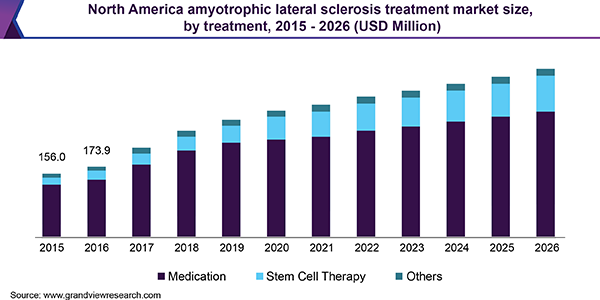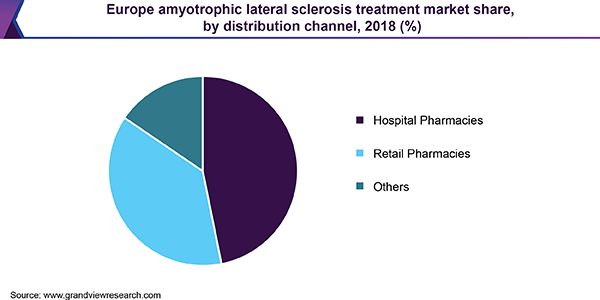- Home
- »
- Pharmaceuticals
- »
-
Amyotrophic Lateral Sclerosis Treatment Market Size Report, 2030GVR Report cover
![Amyotrophic Lateral Sclerosis Treatment Market Size, Share & Trends Report]()
Amyotrophic Lateral Sclerosis Treatment Market Size, Share & Trends Analysis Report By Treatment (Medication, Stem Cell Therapy), By Type (Sporadic), By Distribution Channel, By Region, And Segment Forecasts, 2024 - 2030
- Report ID: GVR-4-68038-001-9
- Number of Report Pages: 100
- Format: PDF, Horizon Databook
- Historical Range: 2018 - 2022
- Forecast Period: 2024 - 2030
- Industry: Healthcare
Report Overview
The global amyotrophic lateral sclerosis treatment market size was estimated at USD 667.3 million in 2023 and is projected to grow at a compound annual growth rate (CAGR) of 5.8% from 2024 to 2030. The increasing incidence and prevalence of amyotrophic lateral sclerosis (ALS), particularly sporadic ALS, which affects 90%-95% of patients, is a major driver of market growth. Furthermore, the growing geriatric population, a key risk factor for ALS, is also contributing to the rise in cases. As the population ages, the demand for effective treatment options is likely to increase.

According to a 2023 study by the National Institute of Health, the global incidence of ALS ranges from 4-6 cases per 100,000 individuals. The market is driven by advancements in treatment options, including the approval of new drugs such as Riluzole, Edaravone, and Nuedexta. This expansion of treatment options provides patients with more choices to manage their condition, paving the way for continued innovation and growth in the market.
Increased awareness and diagnosis are also key drivers of market growth. Rising awareness among patients and healthcare professionals about ALS and available treatment options is boosting diagnosis rates and driving demand for ALS drugs. This increased awareness is likely to lead to earlier diagnosis and treatment, resulting in better patient outcomes and increased market growth.
Favorable reimbursement policies and expansion of distribution channels are also supporting market growth. In regions such as North America, favorable reimbursement policies for ALS treatments are facilitating access to these therapies and driving market growth. The increasing availability of ALS drugs through hospital pharmacies, retail pharmacies, and online channels is broadening patient access and boosting market growth. As the market continues to evolve, it is likely that these factors will contribute to further growth and expansion.
Treatment Insights
The medication segment dominated the market and accounted for a share of 63.1% in 2023. The market relies heavily on medications as they target the underlying mechanisms of ALS, prolonging survival and improving quality of life. Growing awareness and advancements in drug development drive demand for effective pharmacological options.
Stem cell therapy is projected to grow at the fastest CAGR of 7.4% over the forecast period. The market is witnessing growing interest in stem cell therapy, which offers potential solutions through cell replacement, neuroprotection, and inflammation modulation. Promising preclinical and clinical trial results indicate that stem cell therapies may slow disease progression and improve patient outcomes, driving demand and research.
Type Insights
Sporadic ALS accounted for the largest market revenue share of 87.4% in 2023, driven by its increasing incidence among the aging population and rising awareness of the disease. As sporadic ALS lacks a clear genetic link, it presents unique challenges and opportunities for research and drug development, driving demand and growth for FDA-approved medications such as Riluzole and Edaravone.
Familial ALS is expected to register the fastest CAGR of 6.2% over the forecast period, owing to its hereditary nature, with a 50% chance of transmission to offspring. Increased awareness and genetic testing have led to better identification of familial cases, contributing to a rise in reported instances. Research into genetic factors drives interest in targeted therapies, elevating FALS’ profile in the treatment landscape.
Distribution Channel Insights
Hospital pharmacies led the market with a revenue share of 58.4% in 2023. ALS patients require frequent hospital stays and visits for treatment, leading to increased demand for hospital pharmacies. Patients also prefer hospital pharmacies due to easy access to a wide range of ALS drugs and adequate stock, further driving segment growth.

Retail pharmacies are projected to grow at the fastest CAGR of 6.8% over the forecast period, aided by its accessibility and convenience for patients. Retail pharmacies provide easy access to essential medications and offer personalized services, including medication counseling and management support. This combination of convenience and personalized care drives the popularity of retail pharmacies in the ALS treatment landscape, enhancing patient reach and patient satisfaction.
Regional Insights
North America amyotrophic lateral sclerosis treatment market dominated the global market with a revenue share of 37.7% in 2023, driven by high disease prevalence, significant healthcare expenditure, and advanced healthcare infrastructure. The presence of major pharmaceutical companies and favorable reimbursement policies facilitate innovation and patient access to essential drugs. Ongoing research initiatives and increased awareness about ALS further drive market growth, positioning North America as a leader in ALS treatment advancements and improving patient outcomes.
U.S. Amyotrophic Lateral Sclerosis Treatment Market Trends
The amyotrophic lateral sclerosis treatment market in U.S. dominated North America in 2023 is driven by high disease prevalence, significant healthcare expenditure, and advanced healthcare infrastructure. Increased awareness and collaborative efforts between pharmaceutical companies and research institutions position the country as a leader in ALS therapeutic advancements.
Europe Amyotrophic Lateral Sclerosis Treatment Market Trends
Europe amyotrophic lateral sclerosis treatment market held substantial market share in 2023. The region benefits from robust research initiatives, advanced healthcare infrastructure, and collaborative efforts among pharmaceutical companies, academic institutions, and healthcare providers. Increasing awareness and supportive regulatory frameworks promote the adoption of new treatments, driving market growth and positioning Europe as a hub for ALS research and advancements.
The amyotrophic lateral sclerosis treatment market in Germany is expected to grow in the forecast period, fueled by strong research initiatives, advanced healthcare infrastructure, and collaborative efforts among pharmaceutical companies, academic institutions, and healthcare providers. Increasing awareness and supportive regulatory frameworks promote adoption of new treatments, while personalized medicine and targeted interventions fuel market expansion.
Asia Pacific Amyotrophic Lateral Sclerosis Treatment Market Trends
Asia Pacific amyotrophic lateral sclerosis treatment market is expected to register the fastest CAGR of 6.7% in the forecast period, aided byrising healthcare investments, increasing awareness, and improved healthcare infrastructure in countries such as Japan, China, and South Korea. Growing incidence of neurodegenerative diseases and innovative therapies fuel market growth.
The amyotrophic lateral sclerosis treatment market in China is anticipated to register significant growth over the forecast period. Market growth in the country is propelled by increasing healthcare investments, government initiatives, and emerging innovative therapies. Improving healthcare infrastructure, growing incidence of ALS, and pharmaceutical company attention to clinical trials enhance diagnosis and treatment options, contributing to significant market growth potential.
Key Companies & Market Share Insights
Some key companies operating in the market include Mitsubishi Tanabe Pharma Corporation (Mitsubishi Chemical Group Corporation); Biogen; BrainStorm Cell Limited; Amylyx Pharmaceuticals, Inc.; and Ionis Pharmaceuticals, Inc.; among others. Strategic partnerships between pharmaceutical companies and research institutions are accelerating drug development and clinical trials, driving demand for effective treatments and creating opportunities for emerging players.
-
Biogen Inc. is dedicated to developing innovative therapies for neurological diseases, including ALS. Their notable product, QALSODY, is the first therapy targeting the genetic cause of SOD1-ALS, approved by the FDA and recommended for EMA marketing authorization.
-
Sanofi focuses on innovation and collaboration, driving advancements in ALS treatment options worldwide. Sanofi’s commitment to addressing unmet medical needs through research and partnerships positions it as a significant player in the market.
Key Amyotrophic Lateral Sclerosis Treatment Companies:
The following are the leading companies in the amyotrophic lateral sclerosis treatment market. These companies collectively hold the largest market share and dictate industry trends.
- Mitsubishi Tanabe Pharma Corporation (Mitsubishi Chemical Group Corporation)
- Biogen
- BrainStorm Cell Limited
- Amylyx Pharmaceuticals, Inc.
- Ionis Pharmaceuticals, Inc.
- Sanofi
- Otsuka Pharmaceutical Co., Ltd.
- F. Hoffmann-La Roche Ltd
- AB Science
- Sun Pharmaceutical Industries Ltd.
- Orion Corporation
- CORESTEMCHEMON Inc.
Recent Developments
-
In June 2024, Mitsubishi Tanabe Pharma Corporation transferred its European argatroban business to Ethypharm, focusing on Radicava’s treatment agent for ALS in the region.
-
In February 2024, Biogen’s QALSODY, the first SOD1-ALS therapy, received a positive opinion from the European Medicines Agency’s Committee for Medicinal Products.
Amyotrophic Lateral Sclerosis Treatment Market Report Scope
Report Attribute
Details
Market size value in 2024
USD 705.8 million
Revenue forecast in 2030
USD 987.6 million
Growth rate
CAGR of 5.8% from 2024 to 2030
Base year for estimation
2023
Historical data
2018 - 2022
Forecast period
2024 - 2030
Quantitative units
Revenue in USD million and CAGR from 2024 to 2030
Report coverage
Revenue forecast, company ranking, competitive landscape, growth factors, trends
Segments covered
Treatment, type, distribution channel, region
Regional scope
North America; Europe; Asia Pacific; Latin America; Middle East & Africa
Country scope
U.S., Canada, Mexico, UK, Germany, France, Italy, Spain, Denmark, Sweden, Norway, China, Japan, India, Australia, South Korea, Thailand, Brazil, Argentina, South Africa, Saudi Arabia, UAE, Kuwait
Key companies profiled
Mitsubishi Tanabe Pharma Corporation (Mitsubishi Chemical Group Corporation); Biogen; BrainStorm Cell Limited; Amylyx Pharmaceuticals, Inc.; Ionis Pharmaceuticals, Inc.; Sanofi; Otsuka Pharmaceutical Co., Ltd.; F. Hoffmann-La Roche Ltd; AB Science; Sun Pharmaceutical Industries Ltd.; Orion Corporation; CORESTEMCHEMON Inc.
Customization scope
Free report customization (equivalent up to 8 analysts working days) with purchase. Addition or alteration to country, regional & segment scope.
Pricing and purchase options
Avail customized purchase options to meet your exact research needs. Explore purchase options
Global Amyotrophic Lateral Sclerosis Treatment Market Report Segmentation
This report forecasts revenue growth at global, regional, and country levels and provides an analysis of the latest industry trends in each of the sub-segments from 2018 to 2030. For this study, Grand View Research has segmented the global amyotrophic lateral sclerosis treatment market report based on treatment, type, distribution channel, and region:
-
Treatment Outlook (Revenue, USD Million, 2018 - 2030)
-
Medication
-
Riluzole
-
Edaravone
-
Others
-
-
Stem Cell Therapy
-
Others
-
-
Type Outlook (Revenue, USD Million, 2018 - 2030)
-
Sporadic ALS
-
Familial ALS
-
-
Distribution Channel Outlook (Revenue, USD Million, 2018 - 2030)
-
Hospital Pharmacies
-
Retail Pharmacies
-
Others
-
-
Regional Outlook (Revenue, USD Million, 2018 - 2030)
-
North America
-
U.S.
-
Canada
-
Mexico
-
-
Europe
-
UK
-
Germany
-
France
-
Italy
-
Spain
-
Denmark
-
Sweden
-
Norway
-
-
Asia Pacific
-
Japan
-
China
-
India
-
Australia
-
South Korea
-
Thailand
-
-
Latin America
-
Brazil
-
Argentina
-
-
Middle East & Africa
-
South Africa
-
Saudi Arabia
-
UAE
-
Kuwait
-
-
Share this report with your colleague or friend.
![gvr icn]()
NEED A CUSTOM REPORT?
We can customize every report - free of charge - including purchasing stand-alone sections or country-level reports, as well as offer affordable discounts for start-ups & universities. Contact us now
![Certified Icon]()
We are GDPR and CCPA compliant! Your transaction & personal information is safe and secure. For more details, please read our privacy policy.
We are committed towards customer satisfaction, and quality service.
"The quality of research they have done for us has been excellent."





